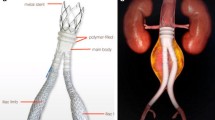Abstract
Purpose
Endovascular repair of an abdominal aortic aneurysm (EVAR) is sometimes not performed in accordance with the instructions for use (IFU) of the endoprosthesis (“off-label use”). We investigated whether the off-label use of the endograft affected the outcomes of EVAR.
Methods
Demographic, anatomical, intraoperative and follow-up data on 100 patients in whom the endograft was used on-label in EVAR were compared retrospectively with the corresponding data of 50 patients with off-label endograft use.
Results
The endograft IFU were most often not followed in patients with challenging aortic neck anatomy or iliac access or fixation, steep neck angulation or bilateral hypogastric artery embolization. Compared with patients in whom the device was used on-label, patients with off-label use had significantly higher rates of intraoperative type I or III endoleaks and proximal aortic cuff placement or other adjunctive procedures. However, there were no midterm differences between the two groups in the rates of type 1b or II endoleaks, sac enlargement, device–limb occlusion or patient survival.
Conclusions
Most midterm outcomes of EVAR in which the endografts were used off-label were similar to those associated with on-label use of the devices. Off-label use of EVAR endoprostheses is feasible, but requires the use of special techniques in patients with challenging anatomical features.

Similar content being viewed by others
References
Parodi JC, Palmaz JC, Barone HD. Transfemoral intraluminal graft implantation for abdominal aortic aneurysms. Ann Vasc Surg. 1991;5:491–9.
Yamasaki R, Komori K, Mori E, Yamaoka T, Kume M, Ishida M, et al. Usefulness of endovascular grafting for abdominal aortic aneurysm (in Japanese). Fukuoka Igaku Zasshi. 1999;90:318–23.
Matsumoto T, Komori K, Furuyama T, Shoji T, Kume M, Yamaoka T, et al. Alternative approach to endoluminal treatment of an anastomotic aneurysm. J Cardiovasc Surg (Torino). 2002;43:403–6.
Hoshina K, Kato M, Hosaka A, Miyahara T, Mikuriya A, Ohkubo N, et al. Middle-term results of endovascular aneurysm repair in Japan: does intraoperative endovascular management against the hostile aneurysmal neck prevent the proximal type I endoleak? Int Angiol. 2011;30:467–73.
Hoshina K, Hashimoto T, Kato M, Ohkubo N, Shigematsu K, Miyata T. Feasibility of endovascular abdominal aortic aneurysm repair outside of the instructions for use and morphological changes at 3 years after the procedure. Ann Vasc Dis. 2014;7:34–9.
Greenberg R, Fairman R, Srivastava S, Criado F, Green R. Endovascular grafting in patients with short proximal necks: an analysis of short-term results. Cardiovasc Surg. 2000;8:350–4.
Eguchi D, Kawasaki K, Matsumoto T. A case of rapid expansion of a saccular abdominal aortic aneurysm with localized dissection. Jpn J Vasc Surg. 2010;19:385.
Angiletta D, Marinazzo D, Guido G, Greco L, Regina G. Spinal cord, bowel, and buttock ischemia after endovascular aneurysm repair. Ann Vasc Surg. 2011;25(980):e15–9.
Miller A, Marotta M, Scordi-Bello I, Tammaro Y, Marin M, Divino C. Ischemic colitis after endovascular aortoiliac aneurysm repair: a 10-year retrospective study. Arch Surg. 2009;144:900–3.
Carroccio A, Faries PL, Morrissey NJ, Teodorescu V, Burks JA, Gravereaux EC, et al. Predicting iliac limb occlusions after bifurcated aortic stent grafting: anatomic and device-related causes. J Vasc Surg. 2002;36:679–84.
Naughton PA, Park MS, Kheirelseid EA, O’Neill SM, Rodriguez HE, Morasch MD, et al. A comparative study of the bell-bottom technique vs hypogastric exclusion for the treatment of aneurysmal extension to the iliac bifurcation. J Vasc Surg. 2012;55:956–62.
Arko FR, Lee WA, Hill BB, Fogarty TJ, Zarins CK. Hypogastric artery bypass to preserve pelvic circulation: improved outcome after endovascular abdominal aortic aneurysm repair. J Vasc Surg. 2004;39:404–8.
Unno N, Inuzuka K, Yamamoto N, Sagara D, Suzuki M, Konno H. Preservation of pelvic circulation with hypogastric artery bypass in endovascular repair of abdominal aortic aneurysm with bilateral iliac artery aneurysms. J Vasc Surg. 2006;44:1170–5.
Lee WA, Nelson PR, Berceli SA, Seeger JM, Huber TS. Outcome after hypogastric artery bypass and embolization during endovascular aneurysm repair. J Vasc Surg. 2006;44:1162–9.
Buth J, Laheij RJ. Early complications and endoleaks after endovascular abdominal aortic aneurysm repair: report of a multicenter study. J Vasc Surg. 2000;31:134–46.
Zarins CK, White RA, Hodgson KJ, Schwarten D, Fogarty TJ. Endoleak as a predictor of outcome after endovascular aneurysm repair: AneuRx multicenter clinical trial. J Vasc Surg. 2000;32:90–107.
Gelfand DV, White GH, Wilson SE. Clinical significance of type II endoleak after endovascular repair of abdominal aortic aneurysm. Ann Vasc Surg. 2006;20:69–74.
Broker HS, Foteh KI, Murphy EH, Davis CM, Clagett GP, Modrall JG, et al. Device-specific aneurysm sac morphology after endovascular aneurysm repair: evaluation of contemporary graft materials. J Vasc Surg. 2008;47:702–6.
Hogg ME, Morasch MD, Park T, Flannery WD, Makaroun MS, Cho JS. Long-term sac behavior after endovascular abdominal aortic aneurysm repair with the Excluder low-permeability endoprosthesis. J Vasc Surg. 2011;53:1178–83.
Acknowledgments
We thank Rie Nishikuma for editorial assistance, Junji Kishimoto for statistical advice, Nicholas Smith for language assistance, Renée J. Robillard for English-language editing and WL Gore and Associates for providing funding for the English-language editing.
Conflict of interest
The authors have no conflicts of interest in relation to the contents of this article.
Author information
Authors and Affiliations
Corresponding author
Rights and permissions
About this article
Cite this article
Matsumoto, T., Tanaka, S., Okadome, J. et al. Midterm outcomes of endovascular repair for abdominal aortic aneurysms with the on-label use compared with the off-label use of an endoprosthesis. Surg Today 45, 880–885 (2015). https://doi.org/10.1007/s00595-014-0978-1
Received:
Accepted:
Published:
Issue Date:
DOI: https://doi.org/10.1007/s00595-014-0978-1




